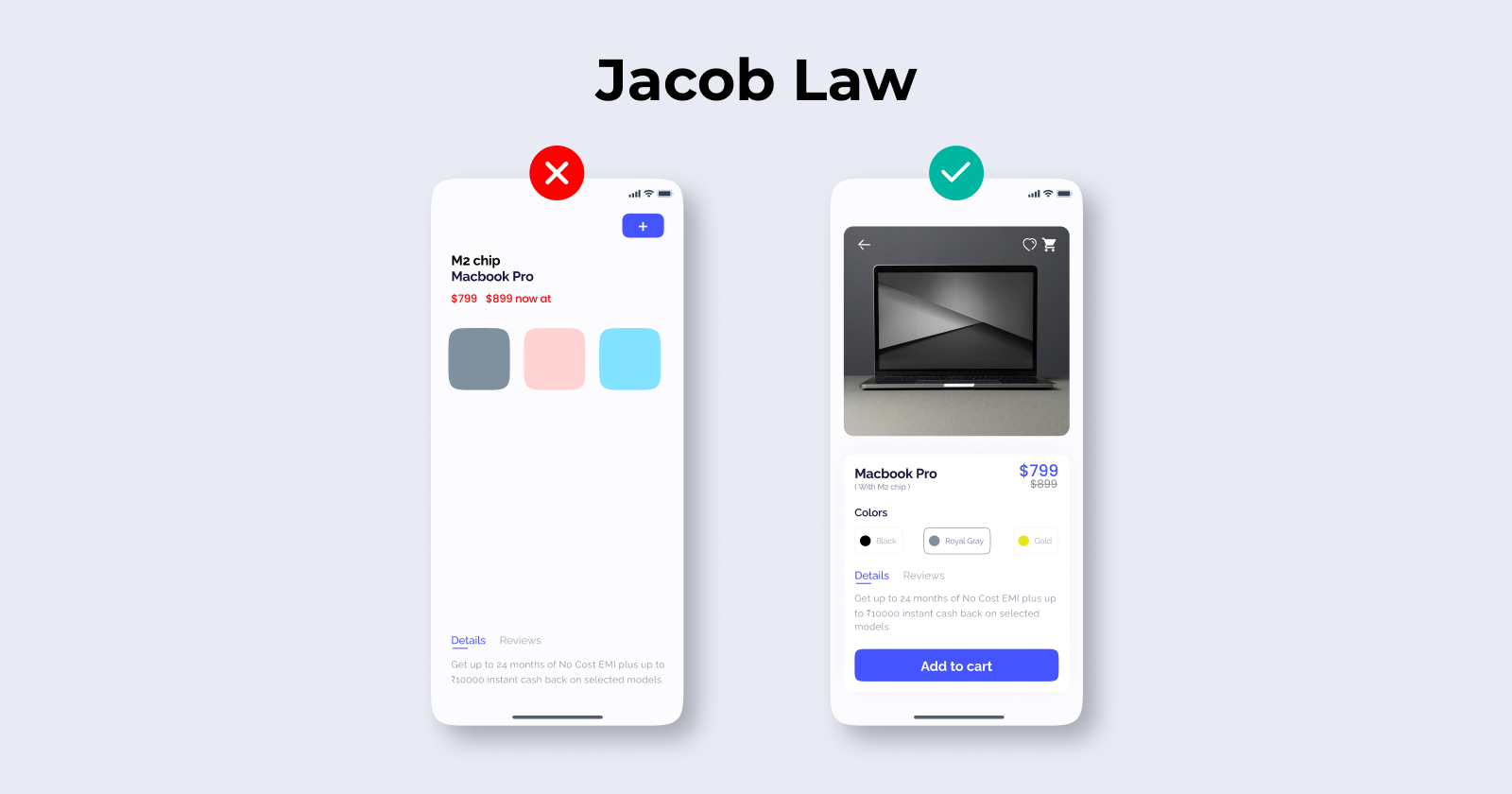Jakob’s Law
 Pravin Shinde
Pravin Shinde
Overview
Understanding user behaviour is critical in UX/UI design since it allows for more intuitive and user-friendly interfaces. Jakob's Law, proposed by usability expert Jakob Nielsen, is a basic notion on which designers rely. According to this law, consumers prefer interfaces that are comparable to those they are already familiar with. In other words, customers want your website and application to behave similarly to the ones they use the most.
This article delves into the importance of Jakob's Law in UX/UI design, its application in digital interfaces, and practical ways for utilising familiarity to improve usability and engagement.
What is Jakob's Law?
Jakob's Law is based on the fact that people form expectations about how digital interfaces should function based on previous experiences. When designers follow common patterns, users can browse a website or app more easily, decreasing cognitive strain and irritation

Key Principles of Jacob's Law:
Familiarity Improves Usability: When interfaces adhere to established norms, users do not need to learn new patterns.
Uniformity Builds Trust: Maintaining design uniformity across platforms increases confidence and credibility.
Faster Decision-Making: Recognisable UI elements allow users to execute activities swiftly and without confusion.
Ignoring Jakob's Law can result in user irritation, higher bounce rates, and lower engagement because users may struggle to navigate an unfamiliar interface.
Why Jakob's Law is Important in UX/UI Design.
Jakob's Law is important because users do not want to spend time learning how to utilise an interface. They anticipate certain design patterns and interactions to behave predictably. Deviating too much from these expectations can result in bad user experiences.
Benefits of Following Jakob's Law:
Reduces Cognitive Load: Familiar layouts and interactions help consumers avoid feeling overwhelmed.
Improves User Satisfaction: A smooth and intuitive experience keeps consumers engaged.
Shortens the learning curve: If users recognise basic design features, they do not require considerable onboarding.
Improves Conversion Rates: If consumers can locate what they need fast, they are more likely to take the intended action.
Use of Jakob's Law in UX/UI Design
1. Navigation and Website Structure
Users want websites to have a consistent structure, such as:
Logo in the top-left corner (clickable to go back to the site)
The top navigation bar contains obvious categories.
Footer with important links (contact, privacy policy, terms of service).
Most e-commerce websites, such as Amazon and Shopify, have a familiar structure that allows customers to easily browse products and complete purchases.
2. Call-to-Action (CTA) placement.
Users expect CTAs to be prominently displayed and visually unique. Best practices include:
Primary call to action above the fold (e.g., "Sign Up" or "Buy Now")
Clear, action-oriented language (e.g., "Get Started" rather than "Click Here")
Consistent colour labelling to distinguish major and secondary actions.
For example, Netflix's "Join Now" CTA is clear and concentrated on its homepage, allowing viewers to take action right away.
3. Forms with Input Fields
Users are aware of conventional form layouts, such as:
Labels above or within input fields.
Asterisks indicate necessary fields.
Inline validation messages for mistakes
Example: Google's login form has a straightforward, universally recognised structure that reduces friction during sign-in.
4. Icons and Visual cues
Certain icons have universal meanings, and straying from them may confuse users. Common icons include:
Magnifying Glass for Search
Shopping cart for online purchases.
Hamburger menu for navigation
For example, Facebook, Instagram, and Twitter employ consistent icons for likes, comments, and shares to ensure that consumers understand their capabilities without the need for explanation.
5. Mobile responsiveness and gestures.
Jakob's Law has expanded to include touch gestures and mobile layouts as mobile usage has increased:
Swipe left/right to navigate.
Pull to refresh for content updates.
Tap and hold for more possibilities.
For example, mobile apps such as Spotify and YouTube use swipe motions and bottom menu bars to meet customer expectations for a smooth mobile experience.
Exceptions and Limitations to Jakob's Law
While Jakob's Law encourages familiarity, there are instances where violating traditions can result in innovation:
New Product Categories: When designing for an emerging technology (e.g., VR interfaces), customers may not have clear expectations.
Brand differentiation: Some brands use unique UI components to stand out, but they should not sacrifice usability.
Improving Outdated Patterns: Some conventional design patterns may be inefficient, and updating them might improve the user experience.
However, any divergence from traditional design patterns should be introduced gradually and with clear instructions to avoid user confusion.
Conclusion
Jakob's Law is a fundamental notion in UX/UI design that emphasises the value of using familiarity to improve usability. By matching interfaces to user expectations, designers may build intuitive experiences that minimise cognitive burden, increase efficiency, and increase engagement.
When innovation is important, blending familiarity with inventiveness ensures that people feel at ease when exploring new features. Following Jakob's Law allows UX designers to create products that are not only visually appealing but also highly useful and user-friendly.
Subscribe to my newsletter
Read articles from Pravin Shinde directly inside your inbox. Subscribe to the newsletter, and don't miss out.
Written by

Pravin Shinde
Pravin Shinde
I've been working in UX and UI design for over 20 years, solving real-world problems in fintech, tourism, and other industries by creating seamless, emotionally engaging experiences that bring in user happiness and business success.